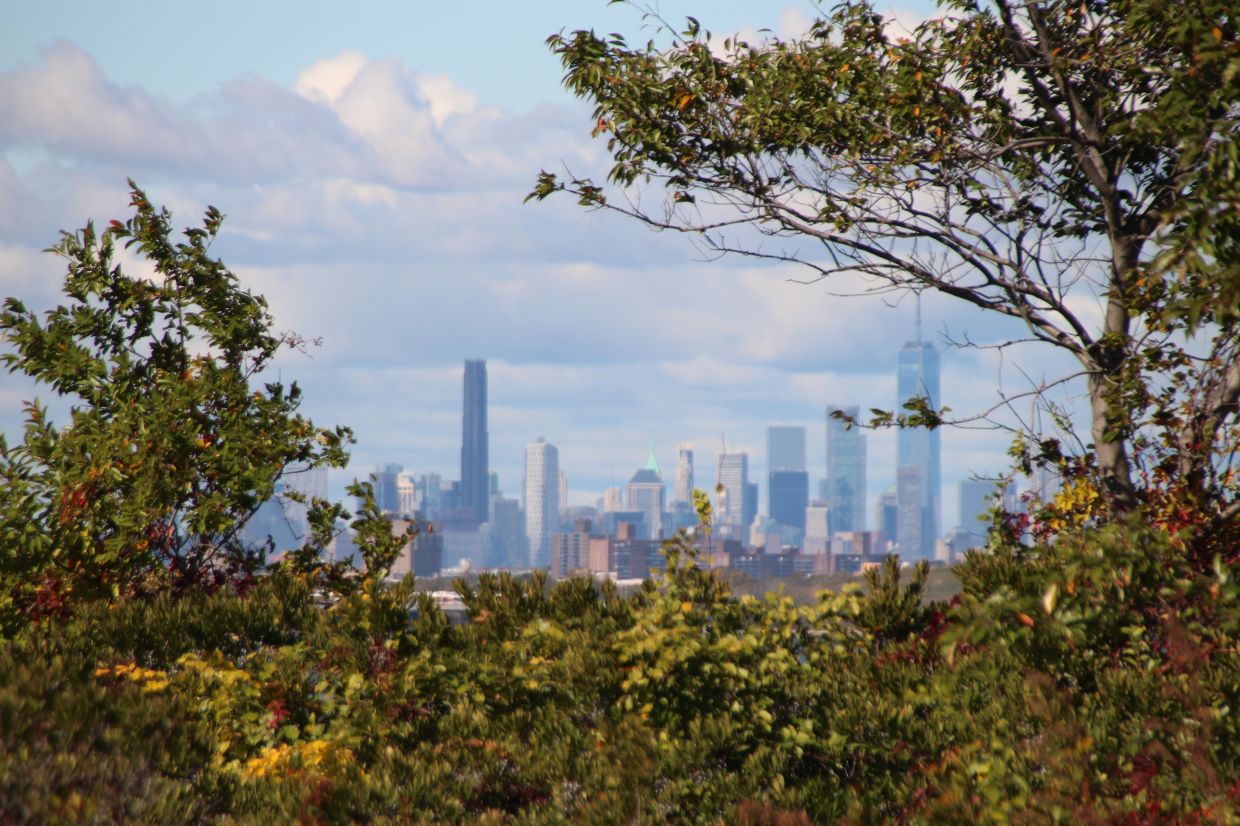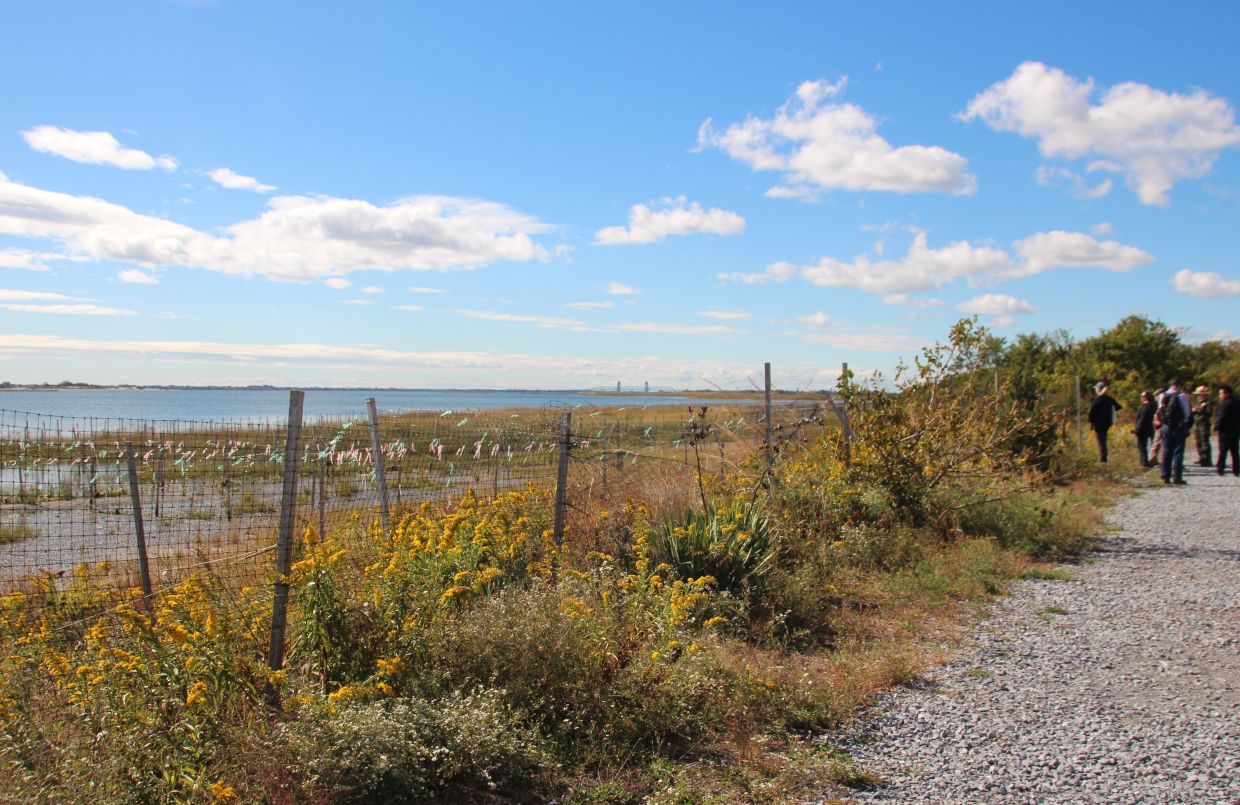Manhattan's skyline, framed by greenery in the Jamaica Bay Wildlife Refuge. Photos: Christina Horsten/dpa
Canadian geese, great egrets and red cardinals can be spotted around the lake, along with turtles and monarch butterflies – and behind the yellow-flowering goldenrods on the horizon, lie the skyscrapers of metropolitan New York, the United States.
More than 300 different bird species have already been identified here, says Daphne Yun, a park ranger. Special nesting platforms have been built for ospreys, which have been so successful that rangers no longer need to build any new ones. A pair of eagles has been coming every year for 32 years, she says.
Yun wears the green uniform of the US Parks Department and works as a ranger at the Jamaica Bay Wildlife Refuge. The nature reserve, along with several other areas in the New York metropolitan area, is part of the Gateway National Recreation Area, which was established around 50 years ago.
Almost nine million people visit the area every year – more visitors than the internationally much better-known Grand Canyon and Rocky Mountain National Parks in the west of the United States put together.
The forests, parks and beaches of the "Gateway" are a popular recreational area for the people of the city that never sleeps – but at least since Hurricane Sandy hit New York in 2012, they have also been at the forefront of the Big Apple's fight against climate change.
Especially Jamaica Bay, which is separated from the Atlantic Ocean by the narrow Rockaway Peninsula in the south-east part of New York City along the boroughs of Brooklyn and Queens, comprising around 70sq km of water, marshland and an entire archipelago of islands. From here, it takes around an hour and a half by public transport to reach the skyscrapers of Manhattan.
For many visitors to New York, Jamaica Bay – whose name has nothing to do with the island state in the Caribbean but is borrowed from the language of the Lenape natives – is the first thing they see of the city. The reason: the major John F. Kennedy Airport is built right next to it.
And tens of thousands of people currently live directly on Jamaica Bay. They are already experiencing repeated flooding, and many houses have already been built on stilts. Scientists at City University of New York warn that, due to rising sea levels and increasing flooding, living directly on the bay could be "unsustainable" by 2050 and impossible by the end of the century if climate change continues to develop as it does at present.
When Hurricane Sandy hit New York in 2012, the area around Jamaica Bay was one of the worst affected. In New York alone 44 people lost their lives and the city estimates the damage to infrastructure, buildings and the economy at US$19bil (RM89bil).
In the Jamaica Bay Wildlife Refuge, the masses of water tore down a wall between the bay and an artificial freshwater lake behind it, which is used by many migratory birds as a place to rest.
"I liked the area and it was breathtaking, not in a good way, but in a horrible way that all of a sudden there was a path and it was no longer there," says Yun.
But the storm has strengthened the commitment of people in the area to climate protection, says Terri Carta from the environmental organisation Jamaica Bay-Rockaway Parks Conservancy.
"In our minds, (it) kind of starts with connecting with parklands as the nature and natural features that help protect our coastlines and offer a wide variety of other amenities for people.
"Together with other partners, the environmental organisation and the US Parks Department have rebuilt the wall. Now they are looking for the best way to fortify it against possible future storms – with a completely new idea for Jamaica Bay.
Carta says they wanted a "living shoreline" by taking things from nature to protect the coast.
In addition to sand, soil, oyster shells, plants and mats made from coconut fibres, one thing in particular worked well: Christmas trees thrown away by New Yorkers at the end of the festive season. Wrapped in burlap made from natural fibres, the trees now line a section of the coast of Jamaica Bay.
"When we walked the shoreline at low tide, we could see very quickly what washed out immediately (and) what didn't. The Christmas trees were genius. They were the ones that were working." – dpa
Manhattan's skyline, framed by greenery in the Jamaica Bay Wildlife Refuge. Photos: Christina Horsten/dpa
The Jamaica Bay Wildlife Refuge, along with several other areas in the New York metropolitan area, is part of the Gateway National Recreation Area, which was established around 50 years ago.
New York's Gateway National Recreation Area
The Gateway National Recreation Area receives almost nine million visitors a year.
New York's Gateway National Recreation Area
Park ranger Yun and visitors in the Jamaica Bay Wildlife Refuge.
New York's Gateway National Recreation Area







